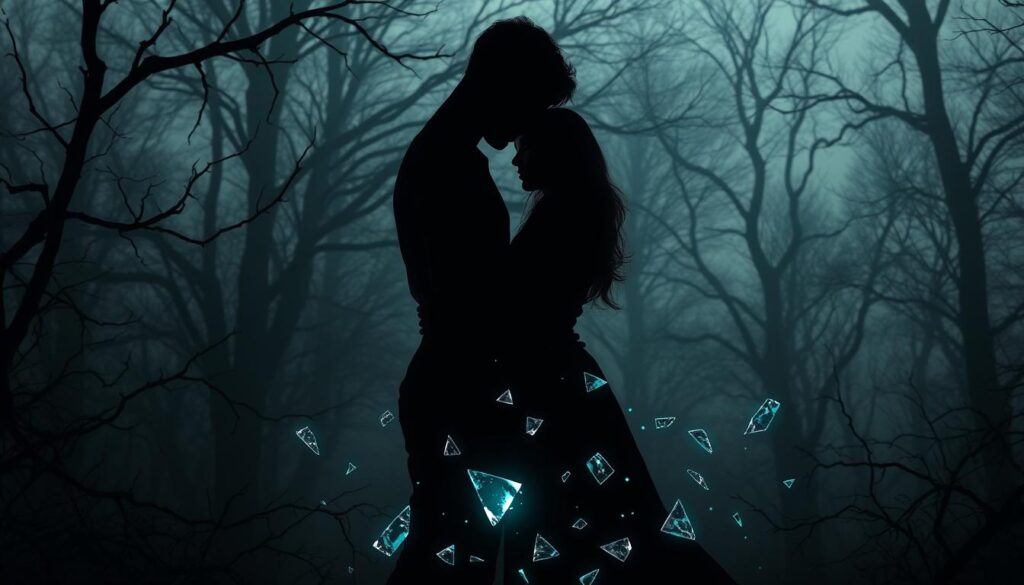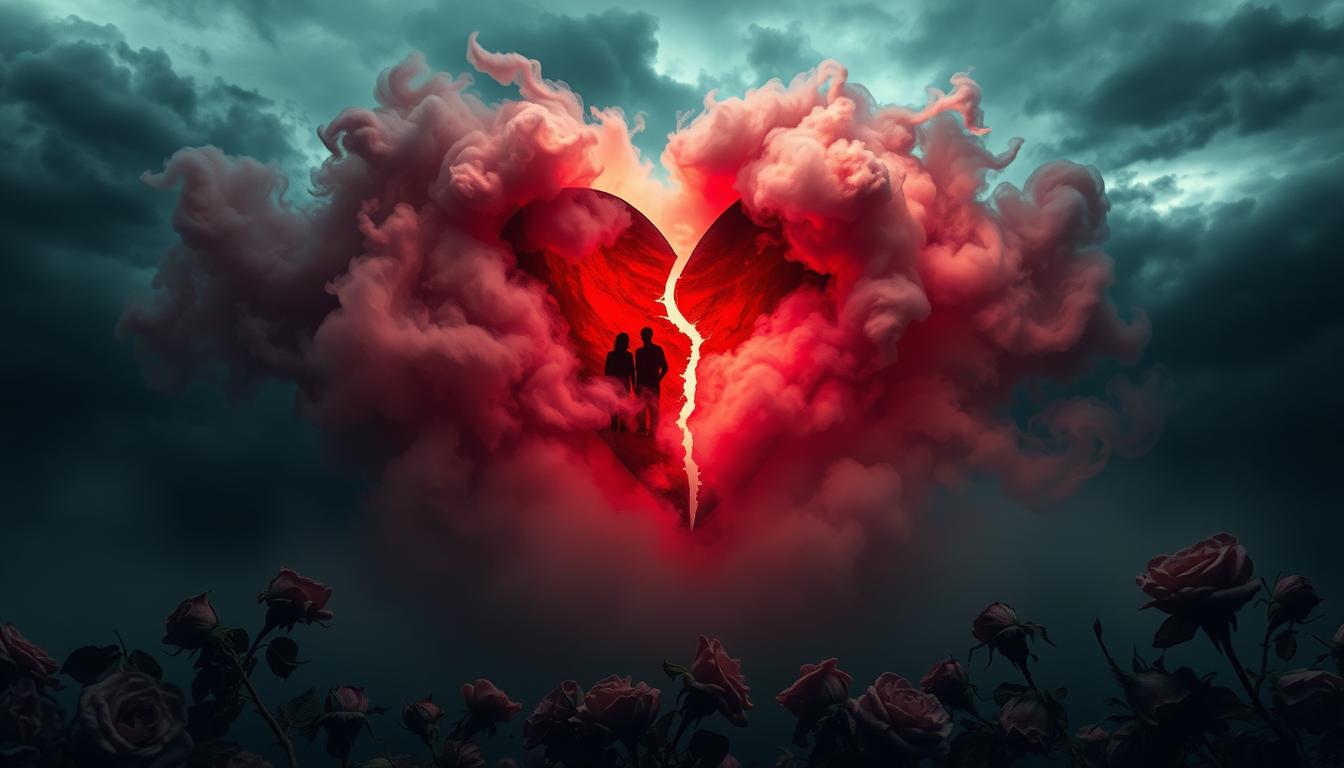Dark romance is a genre that deeply explores human emotions. It creates complex characters whose pasts shape their actions. Love and pain are at the heart of these stories, making them relatable and engaging.
In this genre, characters face their past traumas head-on. Authors weave these experiences into the story, showing how they affect relationships and growth. This creates a powerful and emotional reading experience.
We will dive into how trauma influences dark romance. We’ll look at anti-heroes and redemption stories. This journey will reveal the compelling narratives that draw in readers everywhere.
Understanding Psychological Dark Romance as a Genre
Psychological dark romance mixes strong feelings with complex characters. It looks into the darker sides of love and relationships. It shows how troubled people deal with love.
Defining Psychological Dark Romance
This genre combines passion with psychological tension. Stories often show characters with inner struggles and love interests. It’s different from regular romance because it faces the darker parts of the mind.
Key Elements of the Genre
Key parts of psychological dark romance include flawed heroes, deep emotional battles, and gray areas. Stories use tricky narrators and unusual storylines. The setting reflects the characters’ inner struggles, making it dark.
Popular Themes in Psychological Dark Romance
Common themes include trauma, obsession, and finding redemption. Authors use forbidden love and enemies-to-lovers to add tension. Mental health, past traumas, and growth push the story. These themes weave a complex emotional story that draws readers in.
The Intersection of Trauma and Romance in Literature
Trauma stories in romance books mix deep emotions with complex characters. Writers use tough experiences to make stories that touch readers deeply. These tales show how past hurts affect today’s love lives, making characters’ actions and feelings richer.
Looking closely at romance books with trauma shows how characters grow. Heroes face their past while starting new love stories. This fight often brings out their true selves and growth.
Books that mix trauma and love show how people can be strong. Characters learn to trust and love again, even with hard pasts. This healing through love makes the story more interesting and real.
Adding trauma to love stories makes characters feel real and close to us. This way, authors can dive deep into human feelings and connections. Romance books become more than fun; they teach us about love and healing.
Psychological Impact of Trauma on Characters
Trauma deeply affects characters in dark romance novels. It changes how they think, act, and relate to others. Writers craft complex characters that readers can connect with.
PTSD in Fiction
PTSD in stories reflects real-life struggles. Characters might have flashbacks or nightmares. They might also avoid certain things.
These traits make their stories more real. Authors show how trauma affects their characters’ lives.
Attachment Issues and Relationships
Attachment theory is crucial in dark romances. Characters with trauma find it hard to connect with others. They might fear being left or push people away.
This creates tension and conflict in their love lives. It drives the story forward.
Coping and Defense Mechanisms
Characters find different ways to cope with their trauma. Some turn to bad habits like drugs. Others build walls or become too clingy.
These coping methods shape their stories and the plot. As they heal, they learn better ways to deal with their feelings. This leads to growth and stronger bonds with others.
The Role of Trauma in Shaping Psychological Dark Romance Plots
Trauma is key in creating psychological dark romance plots. It shapes the story’s development, character arcs, and how conflicts are solved. Writers use past traumas to make characters complex and drive the story.
In these tales, trauma is the base for character growth. Heroes deal with old wounds, which shape their choices. This battle is central to their stories, as they explore love and inner struggles.
The story’s structure in these romances focuses on healing from trauma. Scenes like flashbacks and nightmares are part of the plot. This keeps readers hooked and caring about the characters’ paths.
Resolving conflicts in these stories is linked to facing trauma. Characters must overcome their past to grow and love. This journey often ends in healing and deeper connections between them.
By adding trauma, writers craft stories that touch readers. Exploring pain and healing makes the romance more real and fulfilling.
Types of Trauma Commonly Explored in Dark Romance
Dark romance novels dive deep into human suffering. They explore different traumas that shape characters and drive plots. These stories show how painful experiences last, creating complex stories that touch readers.
Childhood Trauma and Its Long-lasting Effects
Childhood trauma is common in dark romance. Characters face scars from early abuse, neglect, or loss. These experiences shape their personalities and how they relate to others.
Sexual Trauma and Its Impact on Intimacy
Sexual abuse is a delicate topic in dark romance. Characters who’ve been abused struggle with trust and intimacy. These stories show the hard work of building healthy relationships with past wounds.
They also talk about recovery and the need for consent.
War-related Trauma and Its Consequences
War trauma is a big part of many dark romance novels. Characters coming back from war may show PTSD signs. These stories show the hard time of getting back to civilian life and connecting with others.
They highlight the hidden scars of veterans and the healing power of love.
Character Development Through Trauma Narratives
Trauma stories are key in shaping characters in psychological dark romance. They delve into the emotional scars of protagonists. This explores their journey to healing and growth.
The road to recovery is filled with self-reflection and facing painful memories. As characters deal with their trauma, readers see deep personal change. This change is the core of compelling redemption arcs.
Emotional healing is central in these tales. Characters learn to trust, form better relationships, and face their fears. This journey mirrors the struggles of readers, making the story relatable.
Through trauma stories, authors show characters’ resilience and strength. These tales entertain and inspire, offering hope to those facing challenges. Psychological dark romance novels leave a lasting mark on their audience.
The Anti-Hero Archetype in Trauma-Driven Plots
The anti-hero trope is key in psychological dark romance. These characters are complex, with flaws and struggles. Their past traumas make them both strong and vulnerable.
Characteristics of the Traumatized Anti-Hero
Traumatized anti-heroes have unique traits. They face moral dilemmas, making choices that are hard to judge. Their past shapes their view of the world, leading to trust issues and a need to isolate.
These characters show both strength and weakness. This mix draws readers into their story.
Redemption Arcs and Character Growth
Redemption is a big part of trauma-driven plots. Anti-heroes face their past, starting a journey of self-discovery and healing. This journey touches readers, who want to see the character change.
The path to redemption is tough, with many obstacles. These challenges test the anti-hero’s will. Writers carefully balance the character’s dark past with their chance for change.
The battle between light and dark in the anti-hero keeps readers hooked. As the story goes on, the character’s growth is key. It drives the plot and offers hope in the darkness.
Trauma Bonding in Dark Romance Relationships
Trauma bonding is key in dark romance novels. It’s a strong emotional tie between characters who share traumatic experiences. In these stories, heroes often fall for partners who hurt or control them.
Authors of dark romance delve into unhealthy relationships through trauma bonding. Characters become dependent on their abusers, thinking intense feelings are love. This cycle of pain and making up keeps readers hooked.

Emotional manipulation is a big part of these stories. The abuser might use gaslighting or love bombing to keep control. Victims find it hard to leave, thinking their abuser is the only one who gets them.
Writers craft compelling stories with trauma bonding. As heroes face and overcome their unhealthy ties, they grow and heal. This journey speaks to readers who’ve faced similar issues.
Dark romance novels about trauma bonding start important talks about relationships. They give readers a safe place to deal with complex feelings. They also help readers spot signs of psychological abuse in their lives.
The Fine Line Between Romance and Toxicity in Trauma-Driven Plots
Psychological dark romance is a delicate balance of love and hurt. Writers have a big challenge in mixing trauma and romance. They must think about the ethics of showing toxic relationships and what readers should know.
Ethical Considerations in Portraying Trauma
Authors need to be careful and sensitive when writing about trauma. They must understand the topic deeply. It’s important not to make harmful behaviors seem good or to stereotype survivors.
They should do a lot of research and maybe even talk to experts. This helps them show trauma in a way that’s fair and accurate.
Balancing Realism and Reader Expectations
It’s important to show trauma realistically but also meet what readers want. Readers want to feel deeply, but we can’t make abuse seem appealing. Using trigger warnings can help readers know what’s coming.
Authors should aim to tell stories that are both moving and true. They should show the journey of healing without losing the realness of the story.
Writers and readers both have a big role to play. Writers need to write with care and knowledge. Readers should think deeply about what they read. Talking openly about these topics helps us all understand trauma in books better.
Healing and Recovery Themes in Psychological Dark Romance
Psychological dark romance shows how characters heal from trauma. These stories show love’s power to help people grow. They dive deep into the human mind, showing how to overcome trauma.
In these novels, therapeutic relationships are key. The main characters find comfort and strength in each other. This bond helps them face their past and move on.
The journey to healing in dark romance is tough. Characters fight their inner demons and learn to trust again. These struggles are shown through intense emotional scenes and deep thoughts, letting readers see inside their minds.
At the end, these stories show love and self-discovery’s power. As characters deal with their past, they grow. This growth is the core of psychological dark romance, offering hope and inspiration.
Writing Techniques for Portraying Trauma in Fiction
Authors use many ways to show trauma in dark romance. These methods help readers feel connected to the characters deeply.
Flashbacks and Memory Fragmentation
Flashbacks are a big part of trauma stories. Writers show memories broken up to show a character’s fight with the past. This shows how hard it is to remember traumatic events.
Symbolism and Metaphors in Trauma Narratives
Symbolism is key in showing complex feelings tied to trauma. Authors use metaphors to show inner wounds or healing. These symbols make the story deeper and let readers see the character’s journey in many ways.
Unreliable Narrators and Trauma
Unreliable narrators are common in trauma stories. This technique makes the story unsure and tense, like the feelings of trauma survivors. It makes readers try to figure out the truth, adding to the story’s depth.
These techniques together make stories that pull readers in and touch their hearts. They let readers see the characters’ mental journeys, making dark romance stories both engaging and thought-provoking.
The Appeal of Trauma-Driven Dark Romance to Readers
Trauma-driven dark romance draws readers into an intense emotional journey. It explores deep human experiences, engaging readers deeply. These stories mix excitement with deep thinking.

These novels offer emotional release. Readers feel the characters’ struggles, experiencing strong feelings. It’s a safe way to explore dark themes and emotions.
Empathy is key in these stories. Readers connect with characters facing past traumas. This bond makes the story feel personal and meaningful.
These stories also dive into the human mind. They show how trauma affects behavior and relationships. It’s both entertaining and insightful, satisfying our curiosity about people.
In the end, trauma-driven dark romance offers a special reading experience. It blends romance with deep psychological analysis. This mix creates stories that resonate deeply and keep readers eager for more.
Critical Analysis of Trauma Representation in Popular Dark Romance Novels
Bestselling dark romance novels show a complex view of trauma. Authors like Colleen Hoover and Pepper Winters have changed how we see trauma in these stories. They dive deep into characters’ mental scars, showing how trauma lasts a long time.
Reviews of these novels point out both good and bad in how trauma is shown. Some authors make characters’ trauma feel real and easy to understand. Others might use trauma just to move the story along, without really getting into its mental effects. Finding the right balance between telling a story and showing trauma responsibly is key in dark romance.
The way trauma is shown in these novels affects readers in big ways. It changes what readers think about trauma in real life. Critics say these books can help people understand trauma better, but they might also make unhealthy ways of dealing with it seem appealing. This debate shows how important it is to show trauma in a thoughtful and accurate way in dark romance books.



